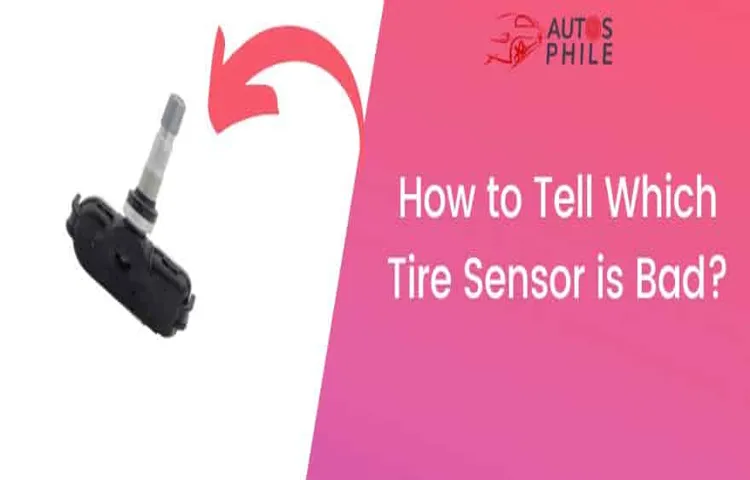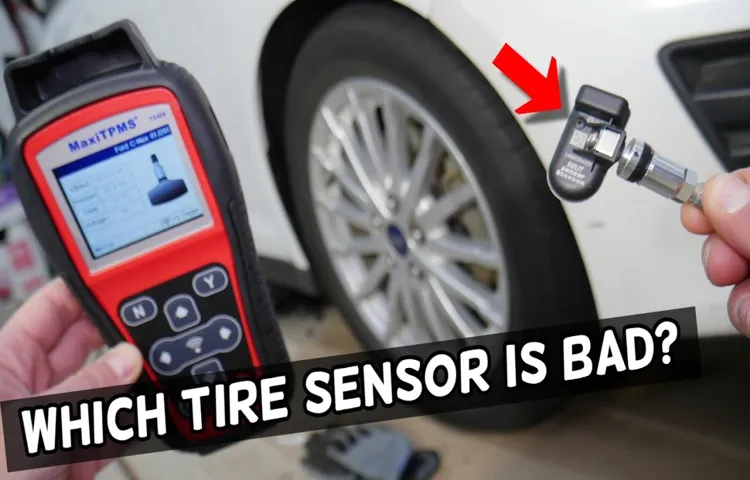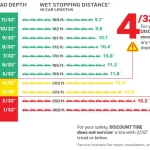Have you noticed your tire pressure light appearing on your dashboard? It might be an issue with your tire pressure sensor. Although these sensors are essential for maintaining safe driving conditions, they can sometimes fail due to various reasons. The tire pressure sensor is responsible for measuring the tire pressure and sending the information to the car’s computer.
If a sensor fails, it can result in incorrect readings and pose a potential safety hazard. Some common reasons why tire pressure sensors fail include a dead battery, damage to the sensor due to collisions or rough driving conditions, or simply wear and tear over time. It’s essential to have your sensor checked regularly by a mechanic to prevent any potential safety issues.
The last thing you want is to be driving on the highway with a malfunctioning tire pressure sensor. Fortunately, modern technology has made it easy for drivers to monitor their tire pressure using digital displays and mobile apps. This technology helps drivers stay informed of their tire pressure status at all times, ensuring their safety on the road.
In summary, tire pressure sensors are crucial for maintaining safe driving conditions. If you notice your tire pressure light appearing, it’s essential to have your sensor checked promptly. The technology available today can help drivers stay informed about their tire pressure status, which can prevent potential safety concerns.
Don’t let a malfunctioning sensor ruin your driving experience – take care of it before hitting the road.
Table of Contents
What is a tire pressure sensor?
Tire pressure sensors are small devices that are found on modern cars to monitor the air pressure within each tire. When working correctly, they will alert the driver when the pressure in a tire drops below the recommended level. However, if your tire pressure sensor is bad, you may not be able to rely on their accuracy.
One way to tell if your tire pressure sensor is bad is if you are constantly receiving alerts about low tire pressure, despite ensuring that your tires have been adequately inflated. Additionally, if the sensor itself appears to be damaged or corroded, this could also be a sign that it is not functioning correctly. It is important to address any issues with your tire pressure sensors promptly to ensure that you are driving safely and that your tires are in good condition.
Explaining TPMS technology
A tire pressure sensor (TPMS) is a technology that monitors the air pressure inside your vehicle’s tires. TPMS helps to ensure proper inflation by alerting the driver when the air pressure is too low, which could potentially lead to tire damage or a blowout. A TPMS typically operates by using a set of sensors placed on each tire’s valve stem, or through a more advanced system that uses readings from a vehicle’s computer or GPS receiver.
This information is then sent to the driver via a dashboard display, warning light, or audible alert. It’s essential to keep your TPMS in good working order to ensure that your vehicle’s tires are inflated to the correct level and to avoid any potential safety hazards on the road. So, it’s always a good idea to get your tire pressure sensor checked and calibrated regularly by a professional technician.

Signs of a bad tire pressure sensor
If you are wondering how to tell if your tire pressure sensor is bad, there are a few signs you can look out for. One of the most obvious signs is if your tire pressure warning light is constantly illuminated, even when your tires are properly inflated. Additionally, if you notice that the pressure readings on your dashboard are inaccurate or fluctuate regularly, this could be a sign that your tire pressure sensor is malfunctioning.
You might also experience difficulty in syncing or resetting the sensor when you try to adjust your tire pressure. If any of these issues persist, it’s a good idea to have your sensor checked by a professional. Neglecting a faulty sensor can lead to reduced fuel efficiency and increased tire wear, so it’s important to address these issues as soon as possible.
By getting regular check-ups and maintenance on your tires, you can ensure your safety and the longevity of your vehicle.
Warning from the dashboard
If you’re driving and a warning light pops up on your dashboard, it could be a sign that something’s wrong with your vehicle. When it comes to tire pressure sensors, there are a few things to watch out for that could indicate a problem. Firstly, if you notice your tire pressure monitoring system (TPMS) warning light is continually on, it could be due to a bad sensor.
Additionally, if you’re getting inconsistent readings from your tire pressure sensors or if the system shows the pressure is low even when it isn’t, that could also indicate a problem. It’s also worth noting that if you’ve recently had your tires replaced or if they’ve been rotated, it’s possible that the tire pressure sensor was damaged in the process. In any case, if you suspect there’s an issue with your tire pressure sensors, it’s essential to have them checked out by your mechanic.
Not only can a bad sensor affect your vehicle’s performance, but it can also impact your safety on the road. Therefore, it’s better to be safe than sorry and address any potential problems immediately.
Inconsistent pressure readings
If you’ve been experiencing inconsistent pressure readings from your car’s tire pressure sensor, it could be a sign of a faulty sensor. This can be a frustrating issue as it can lead to incorrect tire pressure, which can affect your vehicle’s performance and ultimately cause safety issues. Other signs of a bad tire pressure sensor include the warning light on your dashboard illuminating even after adding air to your tires, or the sensor providing inaccurate readings that don’t match the actual pressure in your tires.
It’s important not to ignore these warning signs as they can lead to more serious problems down the line. Take your car into a trusted mechanic to have the sensor inspected and replaced if necessary. Keeping your tires properly inflated is crucial for your safety and the longevity of your vehicle.
Don’t let a bad tire pressure sensor compromise either.
Low tire pressure
Are you experiencing low tire pressure? Have you considered that it may be due to a faulty tire pressure sensor? A tire pressure sensor is responsible for communicating the air pressure of your tires to your vehicle’s computer, which will alert you if your tire pressure is low. Signs of a bad tire pressure sensor may include a constantly illuminated tire pressure warning light, inaccurate readings on your tire pressure gauge, or even the inability to receive a reading at all. Just like any other component in your vehicle, tire pressure sensors may malfunction over time.
If you suspect your tire pressure sensor is faulty, it’s crucial to have it inspected by a professional mechanic. A bad sensor may cause tire damage or unsafe driving conditions, so it’s important to address the issue promptly. Remember, maintaining proper tire pressure not only optimizes your vehicle’s performance but also prolongs the life of your tires.
What to do if the sensor is bad?
If you are wondering how to tell if your tire pressure sensor is bad, there are a few signs you can look for. Firstly, if the warning light on your dashboard remains illuminated even after you have filled your tires to the recommended pressure, this could indicate a faulty sensor. Additionally, if you notice that the pressure readings on your car’s display are consistently inaccurate or fluctuate frequently, there could be an issue with the sensor.
Finally, if you experience difficulty pairing your sensor with your car’s system, this could be a sign of a malfunctioning sensor. If you suspect that your tire pressure sensor is faulty, it is important to get it checked by a mechanic or tire specialist as soon as possible. A faulty sensor can compromise your safety on the road and lead to issues such as uneven tire wear, decreased fuel efficiency, and increased risk of a blowout.
Addressing the issue quickly can help prevent more serious problems down the line and ensure that you can drive confidently, knowing that your tires are in good working order.
Replacing the sensor
If you suspect that your sensor is not working as it should be, there are a few steps you can take to confirm this and replace it if necessary. The first thing you should do is check the sensor’s performance against the manufacturer’s specification chart. If it falls outside the acceptable range, then it’s likely that the sensor is faulty and needs to be replaced.
To replace the sensor, you will need to disconnect it from the wiring harness and remove it from its mounting location. Be sure to take note of how it was positioned so that you can install the new sensor correctly. Once the old sensor has been removed, install the new one in its place, reconnect the wiring harness, and test the system to ensure that it’s working as it should be.
By following these steps, you can quickly and easily replace a faulty sensor and avoid potential issues down the line.
Maintaining your tires
Tire sensor Maintaining your tires is an essential part of responsible car ownership. Regular checks on the tire pressure and condition will keep you safe on the road and prevent costly repairs. However, what should you do if your tire sensor is bad? A bad tire sensor can cause false readings on your vehicle’s dashboard, indicating low tire pressure when it’s not true.
When this happens, you may be tempted to ignore the sensor reading. But it’s important to address the issue quickly. First, check if the sensor simply needs to be reset.
A quick scan with a diagnostic tool can identify the problem. If resetting doesn’t work, it’s time to replace the tire sensor. This will require a professional to remove the old sensor and install a new one.
The process is straightforward and shouldn’t take more than an hour. Damaged tire sensors are mostly caused by age, wear, or tear, or exposure to harsh weather conditions. Therefore, as part of your tire maintenance routine, ensure you check the sensor regularly.
Investing in a quality tire sensor can save you both time and money in the long run, as it will provide accurate readings and prevent false signals that can cause unnecessary worries or accidents on the road. Don’t hesitate to seek help from a professional mechanic if you suspect your tire sensor is faulty.
Conclusion
In conclusion, determining if your tire pressure sensor is faulty isn’t rocket science, but it does require some diligence. A simple technique to determine if your sensor is bad is to check if the tire pressure warning light remains on even after checking and inflating your tires. If it does, it’s time to get your sensor checked by a professional.
Remember, maintaining a healthy tire pressure monitoring system is crucial both for your safety and for your vehicle’s optimum performance. Don’t trip yourself up over a faulty sensor – keep your car on the road and enjoy your ride, because as they say, flat tires are only fun in cartoons!”
FAQs
What are the symptoms of a bad tire pressure sensor?
Some common symptoms include the tire pressure warning light staying on, incorrect readings of tire pressure, and frequent low tire pressure alerts.
Can a bad tire pressure sensor cause tire damage?
Yes, a bad tire pressure sensor can cause tire damage if the tire is underinflated for an extended period of time. This can result in uneven wear and tear, decreased fuel efficiency, and even blowouts.
Is it safe to drive with a bad tire pressure sensor?
While it is possible to drive with a bad tire pressure sensor, it is not recommended. Without accurate pressure readings, you may not be aware of low tire pressure which can lead to unsafe driving conditions.
How long do tire pressure sensors last?
On average, tire pressure sensors can last anywhere from 5 to 10 years before needing to be replaced.
Can a bad tire pressure sensor be repaired?
In some cases, a tire pressure sensor can be repaired instead of being replaced. However, it is important to have a professional mechanic diagnose the issue before attempting any repairs.
How much does it cost to replace a tire pressure sensor?
The cost of replacing a tire pressure sensor can vary depending on the make and model of your vehicle and the location of the sensor. On average, you can expect to pay anywhere from $50 to $250 for a replacement sensor.
Can a tire pressure sensor be reset?
Yes, in some cases a tire pressure sensor can be reset by following the instructions in your vehicle’s owner manual. However, if the sensor is faulty, resetting it may not fix the issue.



